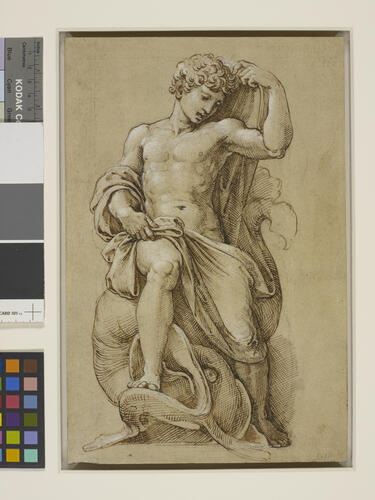Jonah c.1520-3
Pen and ink with white bodycolour over black chalk, on paper washed buff | 30.4 x 20.0 cm (sheet of paper) | RCIN 990804
-
The figure is a version of the marble sculpture carved by Lorenzetto (Lorenzo Lotti, 1490-1541) for the Chigi chapel of Santa Maria del Popolo, Rome. The design of that sculpture has always been attributed to Raphael; the design must have been finalised by 1519, as one of the stucco roundels in the Vatican Loggia reproduces a view (from a different angle) of the statue in low relief. Raffaello da Montelupo, according to his autobiography, completed the companion sculpture of Elias in Lorenzetto's studio in 1523 or shortly afterwards; he does not mention the Jonah, and it is likely that Lorenzetto had finished that sculpture before he left Rome in 1522. (For a full account of the chapel see J. Shearman, ‘The Chigi Chapel in Santa Maria del Popolo’, Journal of the Warburg and Courtauld Institutes, 1961, pp. 129-60.)
Raphael's model for Lorenzetto was probably a small plaster or wax: it cannot have been a drawing of this aspect, which shows the form at its most foreshortened, and thus from the angle least helpful for the sculptor. There are also significant differences in the pose of the sculpture, in the angle of the head, the twist of the body and the form of the drapery. This carefully-executed drawing must instead be a derivation from the designs for the sculpture, for a context in which two-dimensional pattern but not three-dimensional explicitness was important.
The drawing is one of a group of more or less finished drawings from Raphael's immediate circle, including the Rape of Lucretia (RCIN 990506); Venus, Vulcan and Cupid in the Louvre (Cordellier & Py 861); The Madonna and Child with a cloud-borne saint in the Teylers Museum, Haarlem (inv. K.93); Figures before a king at Chatsworth (Jaffé 286); an Antique festival in the Ecole des Beaux-Arts, Paris (E. Brugerolles, Les dessins de la collection Armand-Valton, 1994, no. 80); a St Michael in the Nasjonalgalleriet, Oslo (inv. 15281); and a Baptist in the Wilderness in Edinburgh, possibly a copy of a lost sheet (Raphael: The Pursuit of Perfection, 1994, no. 53).
This group is now usually attributed to Raphael’s long-term assistant Gianfrancesco Penni, though there have been some dissenting views. Konrad Oberhuber has repeatedly argued that this is too generous a view of Penni, and that the author of such enervated drawings as the British Museum Assumption and Coronation, one of the touchstones for Penni’s style group, would not be capable of a drawing as powerful as Jonah. The technique in itself is not unparalleled among Raphael's drawings: a disputed but probably autograph study in the Albertina for the Coronation of Charlemagne (Birke and Kertész 227) is drawn in similarly hard pen-and-white on washed paper, but the handling of the present sheet does not resemble that of any drawings certainly by Raphael. Clayton (Raphael and his Circle, 1999) attributed the drawing (and several others from that group) to Perino del Vaga, on the basis of its similarity of style to RCIN 990344 and an attribution of that drawing to Perino. While elements such as the technique, the bold hatching, the hard, well-defined locks of hair and morphological details such as the feet are similar, this attribution has not been generally accepted.
Of the group of drawings listed above, three – the Rape of Lucretia; Venus, Vulcan and Cupid; and St Michael – served as models for engravings by Agostino Veneziano (respectively RCINs 852202, 851776, 851628; Bartsch XIV, nos. 208, 349, 105), and the Baptist corresponds to a chiaroscuro woodcut by Ugo da Carpi (851514-5; Bartsch XII, p.73, no. 18). All these prints appear to be based on designs by Raphael and were probably produced in the early 1520s, when Raphael's inventions were being recycled in the workshop that continued under Giulio Romano and Gianfrancesco Penni. The clearly-resolved character of this group of drawings suggests that they were produced with print-making in mind; a catalyst for this activity might have been the cessation of work in the Sala di Costantino during the brief pontificate of Adrian VI (1522-23).
It is therefore inherently likely that the Jonah was intended as a model for an unexecuted print. The three-tone technique of buff ground, dark pen and white heightening would be perfect for a two-block chiaroscuro woodcut; lines ruled in chalk along the left and right sides and top of the figure would define the required size of the line block. That said, the Rape of Lucretia was executed in the same technique and was used for an engraving, not a woodcut.
There are copies of the drawing at Dresden (Raffael zu Ehren, 1983, no. 128a), and on the art market (with De Bayser, Paris in 1998).
On the verso of the sheet are a series of small sketches that are quite unlike the Jonah in character, but accord in style and type with a number of drawings reasonably attributed to Gianfrancesco Penni. The largest study, in black chalk only, corresponds with the pose of the maid in the Spinola Holy Family in the Getty Museum, usually attributed to Giulio Romano.Provenance
Probably Royal Collection by 1800, but not identified in George III's 'Inventory A' of c.1810
-
Creator(s)
-
Medium and techniques
Pen and ink with white bodycolour over black chalk, on paper washed buff
Measurements
30.4 x 20.0 cm (sheet of paper)
Object type(s)











